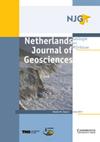New methods of geothermal potential assessment in the Pannonian basin
IF 2.3
2区 地球科学
Q3 GEOSCIENCES, MULTIDISCIPLINARY
Netherlands Journal of Geosciences-Geologie En Mijnbouw
Pub Date : 2020-02-05
DOI:10.1017/njg.2019.7
引用次数: 10
Abstract
Abstract The Pannonian basin in Central Europe is well known for its rich geothermal resources. Although geothermal energy has been utilised, mainly for direct use purposes, for a long time, there are still a lot of untapped resources. This paper presents novel methods for outlining and assessing the theoretical and technical potential of partly still unknown geothermal reservoirs, based on a case study from the Dráva basin, one of the sub-basins of the Pannonian basin along the Hungarian–Croatian border. The presented methods include reservoir delineation based on combining geological bounding surfaces of the Upper Pannonian basin-fill units with a set of isotherms deriving from a conductive geothermal model. The geothermal potential of each identified reservoir was calculated by a Monte Carlo method, which was considered as being represented by the heat content of the fluids stored in the effective pore space (‘moveable fluid’). The results underline the great untapped geothermal potential of the Dráva basin, especially that of the reservoir storing thermal water of 50–75°C, which has the largest volume and the greatest stored heat content.潘诺尼亚盆地地热潜力评价新方法
中欧潘诺尼亚盆地以其丰富的地热资源而闻名。虽然地热能已经被利用了很长一段时间,主要是直接利用,但仍有许多未开发的资源。本文提出了一种新的方法来概述和评估部分未知地热储层的理论和技术潜力,基于对Dráva盆地的案例研究,该盆地是沿匈牙利-克罗地亚边界的潘诺尼亚盆地的一个子盆地。提出的储层圈定方法包括将上潘盆统盆地充填单元的地质边界面与一套由导电性地热模型导出的等温线相结合。通过蒙特卡罗方法计算每个已确定储层的地热潜力,该方法被认为是由存储在有效孔隙空间(“可移动流体”)中的流体的热含量表示的。研究结果表明,Dráva盆地地热潜力巨大,特别是50 ~ 75℃储层体积最大,储热量最大。
本文章由计算机程序翻译,如有差异,请以英文原文为准。
求助全文
约1分钟内获得全文
求助全文
来源期刊
CiteScore
4.00
自引率
25.90%
发文量
14
审稿时长
>12 weeks
期刊介绍:
Netherlands Journal of Geosciences - Geologie en Mijnbouw is a fully open access journal which publishes papers on all aspects of geoscience, providing they are of international interest and quality. As the official publication of the ''Netherlands Journal of Geosciences'' Foundation the journal publishes new and significant research in geosciences with a regional focus on the Netherlands, the North Sea region and relevant adjacent areas. A wide range of topics within the geosciences are covered in the journal, including "geology, physical geography, geophyics, (geo-)archeology, paleontology, hydro(geo)logy, hydrocarbon exploration, modelling and visualisation."
The journal is a continuation of Geologie and Mijnbouw (published by the Royal Geological and Mining Society of the Netherlands, KNGMG) and Mededelingen Nederlands Instituut voor Toegepaste Geowetenschappen (published by TNO Geological Survey of the Netherlands). The journal is published in full colour.

 求助内容:
求助内容: 应助结果提醒方式:
应助结果提醒方式:


